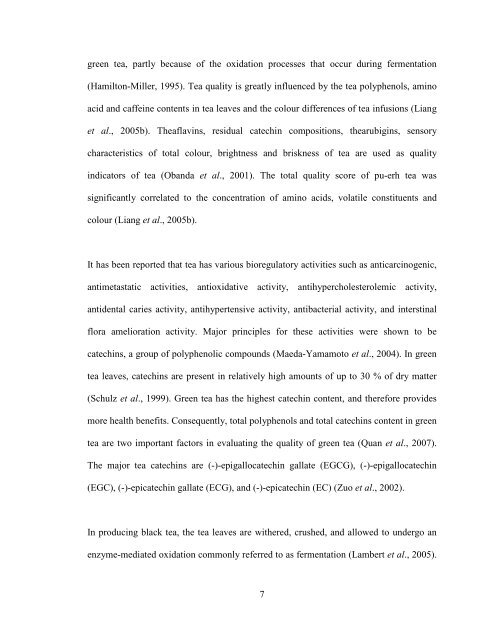a study of the quality of a local herbal tea and volatiles of parinari ...
a study of the quality of a local herbal tea and volatiles of parinari ...
a study of the quality of a local herbal tea and volatiles of parinari ...
You also want an ePaper? Increase the reach of your titles
YUMPU automatically turns print PDFs into web optimized ePapers that Google loves.
green <strong>tea</strong>, partly because <strong>of</strong> <strong>the</strong> oxidation processes that occur during fermentation<br />
(Hamilton-Miller, 1995). Tea <strong>quality</strong> is greatly influenced by <strong>the</strong> <strong>tea</strong> polyphenols, amino<br />
acid <strong>and</strong> caffeine contents in <strong>tea</strong> leaves <strong>and</strong> <strong>the</strong> colour differences <strong>of</strong> <strong>tea</strong> infusions (Liang<br />
et al., 2005b). Theaflavins, residual catechin compositions, <strong>the</strong>arubigins, sensory<br />
characteristics <strong>of</strong> total colour, brightness <strong>and</strong> briskness <strong>of</strong> <strong>tea</strong> are used as <strong>quality</strong><br />
indicators <strong>of</strong> <strong>tea</strong> (Ob<strong>and</strong>a et al., 2001). The total <strong>quality</strong> score <strong>of</strong> pu-erh <strong>tea</strong> was<br />
significantly correlated to <strong>the</strong> concentration <strong>of</strong> amino acids, volatile constituents <strong>and</strong><br />
colour (Liang et al., 2005b).<br />
It has been reported that <strong>tea</strong> has various bioregulatory activities such as anticarcinogenic,<br />
antimetastatic activities, antioxidative activity, antihypercholesterolemic activity,<br />
antidental caries activity, antihypertensive activity, antibacterial activity, <strong>and</strong> interstinal<br />
flora amelioration activity. Major principles for <strong>the</strong>se activities were shown to be<br />
catechins, a group <strong>of</strong> polyphenolic compounds (Maeda-Yamamoto et al., 2004). In green<br />
<strong>tea</strong> leaves, catechins are present in relatively high amounts <strong>of</strong> up to 30 % <strong>of</strong> dry matter<br />
(Schulz et al., 1999). Green <strong>tea</strong> has <strong>the</strong> highest catechin content, <strong>and</strong> <strong>the</strong>refore provides<br />
more health benefits. Consequently, total polyphenols <strong>and</strong> total catechins content in green<br />
<strong>tea</strong> are two important factors in evaluating <strong>the</strong> <strong>quality</strong> <strong>of</strong> green <strong>tea</strong> (Quan et al., 2007).<br />
The major <strong>tea</strong> catechins are (-)-epigallocatechin gallate (EGCG), (-)-epigallocatechin<br />
(EGC), (-)-epicatechin gallate (ECG), <strong>and</strong> (-)-epicatechin (EC) (Zuo et al., 2002).<br />
In producing black <strong>tea</strong>, <strong>the</strong> <strong>tea</strong> leaves are wi<strong>the</strong>red, crushed, <strong>and</strong> allowed to undergo an<br />
enzyme-mediated oxidation commonly referred to as fermentation (Lambert et al., 2005).<br />
7


